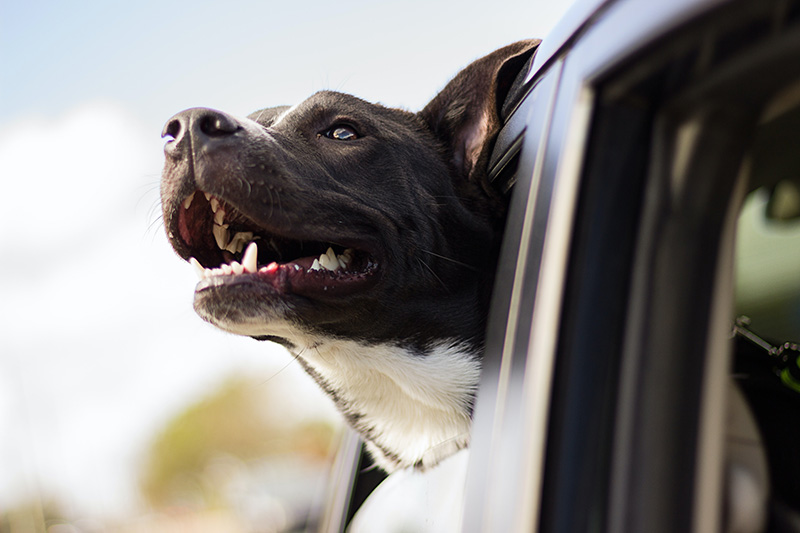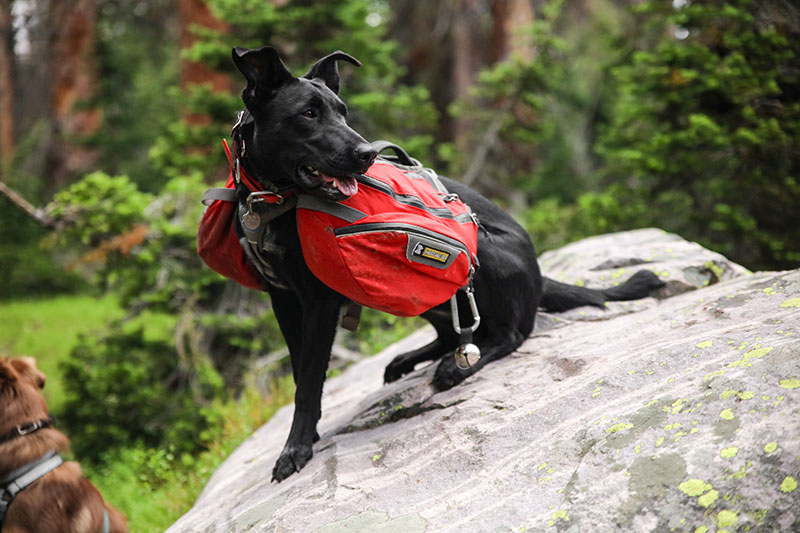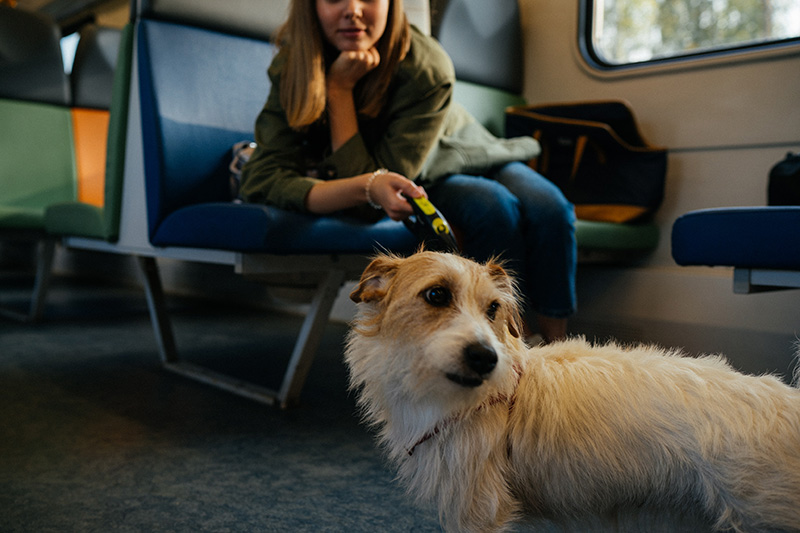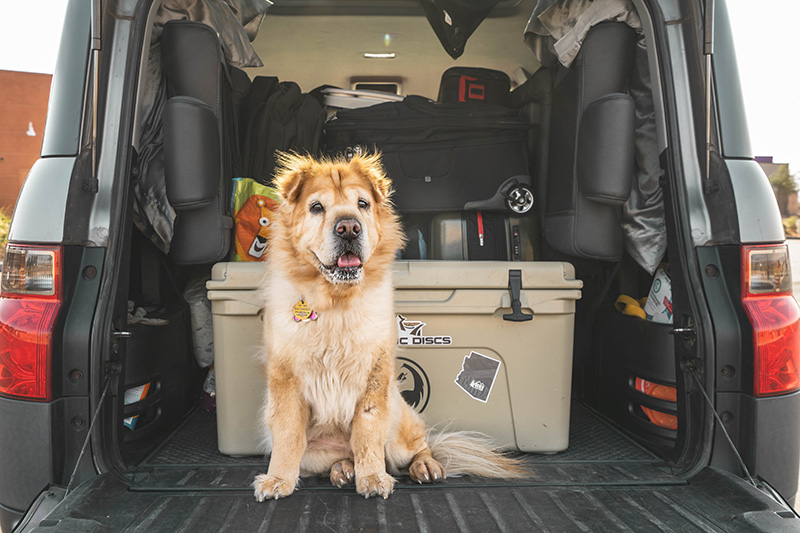Global Rescue member Rob Beaton has been traveling with his dogs for more than 20 years. In April and May 2021, he made a 3,418-mile loop around Baja, California, with his three travel companions: Whitney, Senna and Willow.
A seasoned traveler, Beaton has developed what works for his dog family: voice control for off-leash exercise, leashes for urban areas and border crossings, and hamster cage water bottles for constant water access in the vehicle.
[Related Reading: Hiking Safety Tips for You and Your Dog]
You’ll want to develop your own methods to keep everyone — two and four footed — safe and happy on your trip. Whether you’re opting for a road trip or an international destination this fall/winter, here’s a list of considerations for safe and smart travel with your dog.
Start Small

Your pet’s first trip should be a short one. In fact, plan a few trips with gradually longer distances: a car trip to a local dog park, a car trip for an overnight at a friends’ house, then a lengthy car trip to a pet-friendly hotel for a weekend. Practice — and have contingency plans in place if at any point your dog becomes anxious.
Global Rescue members Chelsea and Rebekah Bakos-Kallgren have been practicing backyard camping with their 1-year-old puppy, Abol, before scheduling a 2022 summer trip.
“We use an old tent and old sleeping bags perfect for sharp puppy nails,” said Bakos-Kallgren. “The rain fly creates a vestibule so she’s in her dog bed, outside the tent, but near us. It took a lot of treats but our first try was a success.”
Visit Your Vet
Even if you are just crossing state lines for a week-long vacation, make sure your dog is healthy. Check in with your local veterinarian, make sure all vaccinations are up to date, and get a baseline health status to bring any underlying conditions to light before travel.
When traveling internationally with your pet(s), there may be animal health requirements for that destination. According to the U.S. Department of Agriculture Animal and Plant Health Inspection Service, factors to consider may include meeting time frames for obtaining a health certificate, updating vaccinations, diagnostic testing, or administration of medications/ treatments.
Bring Paperwork
Just as you would bring your driver’s license and passport, your dog will need a collar with ID tags. It’s also wise to pack a copy of your dog’s vaccination records, which you might need if your pet is ill or needs to be boarded for a day during your trip. Usually a copy on your phone will be enough, or you can keep a copy in your glove box for safe keeping. Be sure to have a photo of your pet and any microchip documentation if they do happen to leave your side.
Have the Right Safety Gear

Your pet will need a variety of safety devices depending on the type of vacation you have planned: a carrier or harness for car travel, a life jacket for water exploration or a reflective vest for hiking. A microfiber dog towel is handy there’s unexpected bad weather or water play.
You’ll also pack food, snacks and plenty of water. Make sure you have a water bowls for a variety of situations, such as stable for car travel or collapsible for on the go. Water should be accessible at all times — like Beaton does with the hamster cage water bottles — so your pet doesn’t have to wait for you to stop for gas before getting a drink. Safe Travel partner Orvis offers a no-splash travel bowl as well as a weekender kit with collapsible bowls.
Research Your Destination
AAA, North America’s largest motoring and leisure travel organization, suggests researching your travel plans specifically for your pets. This means not only state animal policies — Hawaii, for example, requires a five-day quarantine period for pets who meet pre- and post-arrival requirements — but also drilling down to city, county and municipality breed-specific regulations.
- Never show up to a location assuming it is pet-friendly. Depending on your plans, you’ll want to research:
- Hotels: some allow pets to stay for free while others have a per-night fee
- Campground or RV park: many have leash laws
- National parks: many have strict dog regulations due to wildlife
- Restaurants: some outdoor seating establishments welcome pets
Prepare for Pit Stops
Beaton stops hourly to let his dogs run. “There are plenty of side roads and trails with little traffic where they can run off-leash,” he said. “Sometimes we have to get a bit creative. Cellular tower roads are great. They are usually near major roads or highways and only fenced near the tower, giving us plenty of room to run.”
You could also look for a dog park — fenced-in areas where your dog can run off-leash under your supervision — in your destination. Dogfriendly.com and BringFido.com each offer a list of dog parks for every town in the United States.
Not comfortable leaving your pet alone in the car, even for a moment? The Humane Society of the United States recommends traveling with one other human on a long drive so you can take shifts using the rest room or stopping for supplies.
Check-In with the Airline

Plane, train or boat — each transportation provider has its own set of rules. Amtrak charges a fee for small dogs and cats in a carrier (20 pound maximum). Unless you have a service animal, pets are typically not allowed on cruise lines and, if they are, will most likely stay in the ship’s kennel. If you are bringing your pet on a plane, each airline has its own requirements for in-cabin pets from booking to airport arrival to destination. United asks your pet remain in its kennel at all times.
Traveling Internationally with Your Dog
More than two million pets travel by air each year, according to the U.S. Department of Transportation. They offer this advice for transporting your pet:
- Check the condition of the kennel from top to bottom, including the security of the door latch.
- Write your name, address and phone number on the kennel, and make sure your pet is wearing a tag with the same information.
- Make sure your pet is used to the kennel long before the trip.
- Do not give your pet solid food in the six hours prior to the flight, although a moderate amount of water and a walk before and after the flight are advised.
- Do not administer sedation to your pet without the approval of a veterinarian, and provide a test dose before the trip to gauge how the pet will react.
- Be sure to reserve a space for your pet in advance, and inquire about time and location for drop-off and pick-up.
- Try to schedule a non-stop flight; avoid connections and the heavy traffic of a holiday or weekend flight.
- When you board, tell a pilot or a flight attendant there is a pet in the cargo hold. The airlines have a system for providing such notification, but it doesn’t hurt to mention it.
Bring a First Aid Kit
The American Kennel Club has a comprehensive list of first aid kit items for your dog: gauze, non-stick bandages, scissors, tweezers and an antibiotic spray (or ointment) to treat cuts, sores, rashes, dry skin and allergies. Orvis, a Global Rescue Safe Travel Partner, has a field dog first aid kit with surgical-quality instruments and a 93-page field guide. It can be separated into two kits: one to carry in your vest, the other to keep in your vehicle.
Coronavirus Concerns
According to the Centers of Disease Control and Prevention (CDC), the virus causing COVID-19 can spread from “people to animals including pets in some situations, mostly during close contact.” The numbers have been small, but if you’re worried about your pet catching the virus it is best to keep them at home or in locations, such as a friend’s home, where you know everyone is vaccinated. Pets should not wear masks and hand sanitizer should not be used on their fur or skin.
Watch the Weather

Your dog may have a fur coat, but they get cold just like you do. Most dogs will be fine outside in the winter for short periods of time, but dogs with fine hair (greyhounds), smaller breeds (Chihuahuas) and older dogs may need a sweater or coat for longer walks, hikes or treks.
Flying? When the outdoor temperature drops below 45 degrees Fahrenheit, airlines declare a “no-fly day” and pets are not allowed to fly. It will be too cold on the tarmac for your dog.
Have a Plan in Place
What happens to your pet if you are incapacitated?
“Understand your dog may not be able to evacuate with you,” said Adam Bardwell, supervisor of operations at Global Rescue. He notes mitigating factors such as helicopter weight limits, stress level of the pet, and the pet-friendliness of your destination. “Assume your dog will not be cared for if you do not have a plan in place.”









